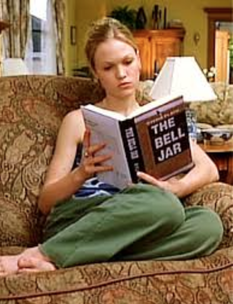 Ten Things I Hate About You
Ten Things I Hate About You
Length: 750 words.
We began the term with Zadie Smith's essay, "Generation Why?" (2010) and E. M. Forster's story "The Machine Stops" (1909). Both writers depict different versions of the present and future, envisioning how aspects of communication, family, and education may change. By contrast, Sylvia Plath's novel The Bell Jar critiques the world of midcentury Manhattan, from its use of the death penalty, to its limited roles for women. Your task in this essay is to pair either Smith's essay or Forster's story with Plath's novel, asserting an argument about the worlds they address. What futures does each narrative suggest is possible? How does each suggest that the present can change?
750 words is not long (approximately three pages), so you will need to select a narrow focus that you can examine in depth. You are also welcome to analyze Plath's poems, letters, journals, or interpretations of her work, but make sure you cite them. As you begin to draft your essay, you can build from your blog postings, addressing places or ideas in greater depth, but make sure your essay reads fluidly.
You must demonstrate appropriate use of quotations and cite all sources you consult, including webpages. Use parenthetical citations to acknowledge when you are quoting or citing others’ ideas. It is plagiarism to use others’ words or ideas without citing them. This is an academic essay, so it should demonstrate appropriate conventions, including tone, language, and word choice. You should avoid using the first person, I.
Remember, you do not need to summarize the texts we have read. Assume your readers have read them and only tell them what they need to know to understand your points.
Your essay must be typed, double-spaced, in twelve-point, and Times New Roman font.
Developing Your Argument
- Select quotations and an image to analyze. You only need to quote when the language of the quotation matters to your argument. Otherwise, you can put a quotation in your own words.
- As you return to the text, formulate an argument by asking what links the evidence you selected. Ask yourself how they differ from each other and other moments. These questions will allow you to answer why each instance is significant to the novel.
- Consider the form and style of the examples you select. Analyze the word choice and tone. Where in the novel do the instances that you note take place? Why is this significant?
Essay Structure
- As you plan your essay, consider analyzing two to three quotations or examples per paragraph. If quotations are more than four lines in length they need to be indented as a block quotation. Be selective and only quote the words, phrases, or lines necessary to your argument. In addition, fully analyze the quotations you have selected. Sometimes, you might deal with only one quotation or example in a paragraph if it demands that much explication.
- Your introductory paragraph should introduce your claim and why it is significant. Remember that your introduction can change until the last minute and often it is a good technique to make your conclusion your introduction.
- Each topic sentence should assert the argument of the body paragraph it begins. Your analysis in each paragraph should support the topic sentence. The topic sentence of each paragraph should support your claim in the introduction.
- The conclusion of your essay does not need to repeat what you have already said. In light of what you have argued, make a connection to a larger context and suggest ideas for further research.
Assessment Rubric
Your essay will be assessed using the following criteria:
Exceptional.
- A thought-provoking essay, clearly written and carefully argued, demonstrating creativity and thorough engagement with texts.
- The essay supports a focused thesis, considering its implications.
- The essay reflects careful reading of texts and interpretation of evidence. Quotations are analyzed and incorporated effectively, functioning as a part of sentences.
- The topic sentences support the thesis and state what each paragraph argues.
- The essay demonstrates creativity in its approach to the subject.
- The sentences throughout demonstrate clear, engaging use of language.
- The essay's title draws in readers, introducing them to the essay's argument.
- The conclusion draws the argument to a close, makes a connection to a new context, and suggests directions for future research.
- The essay demonstrates correct use of grammar, punctuation, and MLA style for in-text citations and list of works cited
Strong.
- The essay contains a thesis, supported by analysis of quotations and examples.
- The implications of the thesis could be considered further.
- The organization of ideas could be stronger.
- The quotations could be more fully analyzed.
- The conclusion could consider further future directions for research.
- The topic sentences could more effectively address what each paragraph argues.
- The essay could demonstrate further revision and proofreading, including use of MLA style for in-text citations and list of works cited.
Satisfactory. The essay is reasonably focused, and explanations or analyses are mostly based on examples or other evidence. Fewer connections are made between ideas, and though new insights are offered, they are not fully developed. The essay reflects moderate engagement with the topic. It contains errors in grammar, punctuation, or MLA style (and list of works cited).
Underdeveloped. The essay is mostly description or summary, without consideration of alternative perspectives, and few connections are made between ideas. The post reflects passing engagement with the topic. It contains many errors in the use of grammar, punctuation, or MLA style.
Limited. The essay is unfocused, or rehashes previous comments, and displays no evidence of student engagement with the topic.
No Credit. The essay is missing or consists of disconnected sentences. It demonstrates plagiarism: presenting others' ideas as your own, pasting content from sources (including websites), or drawing on such content without citing it.
Adapted from https://www.chronicle.com/blogs/profhacker/a-rubric-for-evaluating-student-blogs/27196